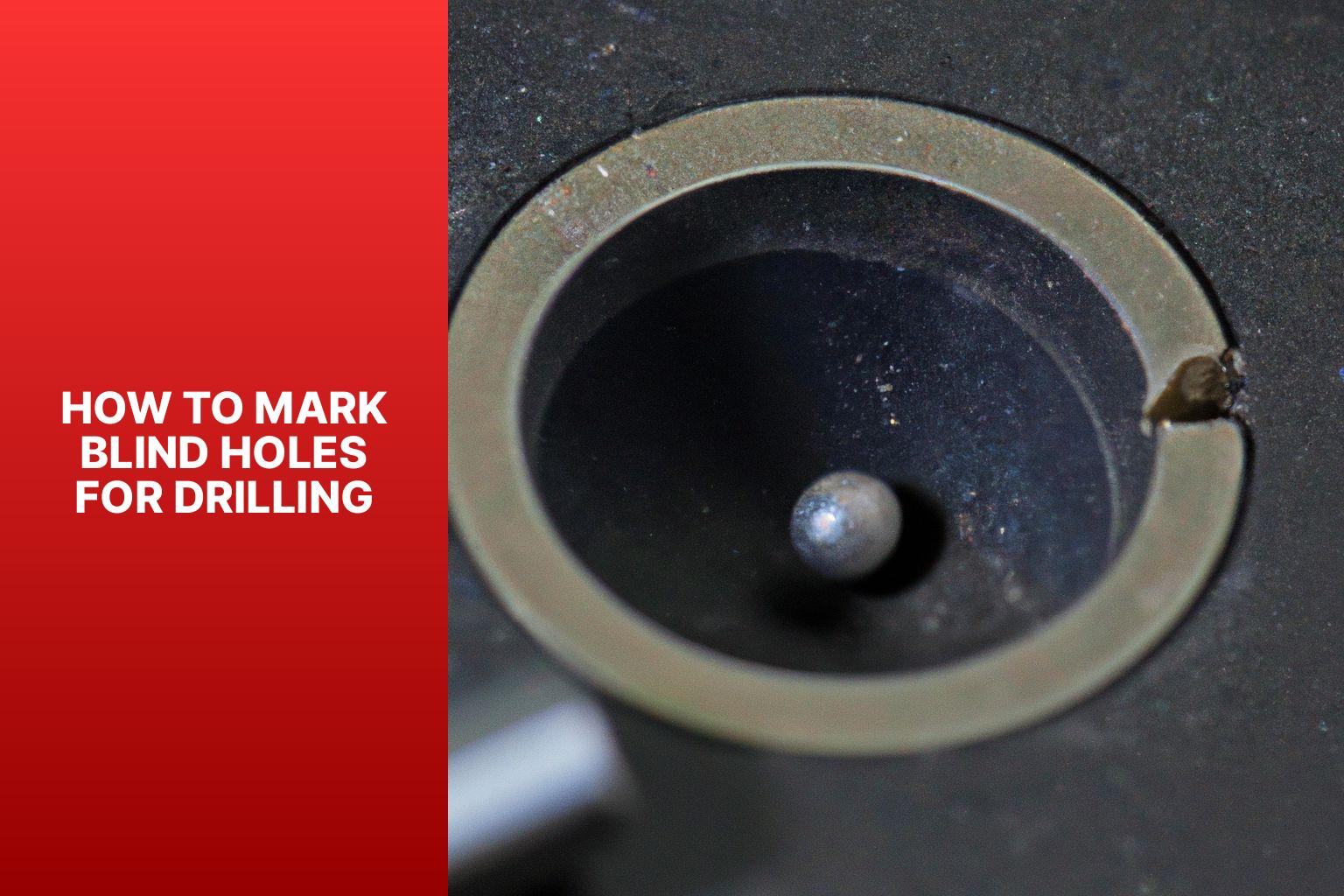
“Woodworkers and metalworkers often struggle with alignment issues, frequently asking How to Mark Blind Holes for Drilling to ensure perfectly matched parts.”
Precision is essential when marking blind holes for drilling. Knowing how to do it right helps ensure smooth drilling and accurate results. But first, what’s a blind hole? It’s a hole that doesn’t go all the way through the material. Its depth can’t be determined just by looking. To mark these holes accurately, you need to take extra steps.
A center punch is a great tool. It has a pointy end that you press into the material surface. This makes an indentation, which is a guide for the drill bit. With careful placement, you’ll mark the blind hole precisely.
Or, you can use tape or adhesive markers. These don’t leave permanent marks on the surface. Just place the marker over the hole location and drill away.
For more complex projects or materials like metal or wood, specialized tools may be needed. A scribe or measuring tool can help you mark with accuracy and consistency.
Table of Contents
“Best Techniques: How to Mark Blind Holes for Drilling”
Accuracy in marking blind holes is essential for successful drilling. Misalignment can lead to wasted time, effort, and resources. So, it’s critical to mark them accurately. Here are the steps:
- Understand their purpose. Blind holes are drilled to a certain depth, without penetrating the material. They are used for creating spaces for screws, bolts, or dowels.
- Measure precisely. Use reliable tools like calipers or measuring tapes. Make sure to double-check measurements to reduce errors.
- Use the right marking techniques. For softer materials like wood, pencils or markers can be used. For harder materials like metal or plastic, center punches or awls are better.
Safety is also important. Wear protective gear such as safety glasses and gloves. Make sure to use the correct drill bit size and type.
In the past, craftsmen had fewer tools and techniques for marking blind holes. This often resulted in varying degrees of accuracy. With new technology and precise measuring tools, marking blind holes today is more efficient and accurate.
Materials needed for marking blind holes
The art of marking blind holes requires special materials. Here’s what you need for precise position and accurate drilling: Masking tape, center punch, drill bit set, and depth stop collar.
Masking tape provides a clear visual guide without damaging the surface. Center punches help prevent drill bits from slipping. Choose the right drill bit size for your project. The depth stop collar stops over-drilling.
Before marking blind holes, clean and prepare the surface. Wear safety gear like gloves and goggles for power tools.
Blind hole drilling dates back centuries. Ancient civilizations used craftsmanship and intuition to mark blind holes. Now you know what you need to tackle your drilling projects with precision.
Step 1: Gather the necessary tools and materials
To mark blind holes for drilling, gathering tools and materials is the first step. Here’s a guide:
- Get a measuring tape. This helps to determine the dimensions and depths.
- Center punch to create an indentation on the material.
- Drill bits to suit different materials.
- Safety goggles for protection.
- A corded or cordless power drill.
- Lubricants to reduce friction.
For specific projects, you may need accessories like clamps or vices. To maximize efficiency and accuracy, here are some tips:
- Double-check measurements before starting.
- Consider the material and adjust tools/techniques.
- Clean previous debris for accuracy.
- Use a steady hand and consistent pressure.
By following these steps, gathering the necessary tools and materials is easier when marking blind holes for drilling. This preparation will ensure smooth and accurate blind holes.
Step 2: Measure and mark the spot for the blind hole
Accuracy is a must when marking blind holes for drilling. Measure then mark the spot first. Here’s how:
- Use a measuring tape or ruler to spot the hole.
- Use a center punch to make a small indent. This will be your starting point.
- Use a self-centering punch for more accuracy.
- Put your drill bit on the marked spot, perpendicular to the surface.
- Gently press and start drilling, keeping control.
Follow these steps for precise marking of blind holes. Attention to detail is very important!
Pro Tip: Double-check measurements and markings before drilling. Also, use safety equipment like goggles and gloves.
Step 3: Choose the appropriate method for marking the blind hole
Picking the right way to mark blind holes is key for drilling. It makes sure the holes are accurate and stops missteps while drilling. To select the right marking, do these four things:
- Check out the hole: Inspect the depth, diameter, and material of the hole. This helps you pick a good marking that is visible and exact during drilling.
- Think about the material: Different materials need different marking. For example, a center punch may work on metal, but a pencil or marker could be better on wood or plastic.
- Use templates or guides: If you need to mark multiple holes with the same spacing, try a template or guide. These tools make sure they are all even and save time.
- Test your marking: Before drilling, test your mark on a scrap piece of material. This lets you see if it is visible and accurate.
Remember, picking the right marking method is important to get precise placement and avoid expensive blunders. There have been cases when wrong markings caused accidents during drilling. One such incident happened in a building site where workers used the wrong tool to mark blind holes on concrete pillars. Because of low visibility and bad marks, many holes were drilled wrong, causing structural problems and delays in the project.
So, it is essential not only to follow the proper steps, but also to test them in advance to ensure ideal results and stop possible harm or issues from inadequate markings.
Step 4: Position the drill and prepare for drilling
Positioning your drill correctly is key to achieving precise blind holes. Follow these four steps for success:
- Adjust the drill’s depth stop or collar to match the depth of the hole you want. This will stop you from drilling too deep and damaging the piece.
- Mark the center with a center punch or nail to give the drill bit a starting point. This will help make sure the hole is accurate.
- Clamp down the workpiece to keep it stable. This will reduce the risk of misalignment.
- Hold the drill perpendicular to the surface and stay steady.
To ensure even better results, take note of the following:
- Select the right speed for the material.
- Use pilot holes for more delicate materials like wood.
- Double-check all measurements.
If you follow these steps and suggestions, you will be able to set up your drill accurately and prepare for drilling blind holes with no issues.
Step 5: Secure the workpiece and begin drilling
Securely drill blind holes? Here’s how:
- Clean then position the workpiece.
- Secure the workpiece with a clamp or vise.
- Remove any debris and obstructions.
- Select a drill bit size for the hole diameter.
- Drill slowly & steadily with firm pressure.
Plus, always wear safety goggles! Drilling safely is key.
Fun fact: Blind holes are used in woodworking for hiding screws and creating a neat finish. Source: DIYNetwork.com.
Tips for drilling blind holes accurately
- Measure the depth with a caliper or depth gauge.
- Choose a drill bit size based on the hole’s diameter.
- Securely attach the drill bit to the drill machine chuck.
- Mark the hole location with a center punch or marking tool.
- Position the drill perpendicularly on the workpiece surface and start drilling slowly.
- Occasionally withdraw the drill bit to clear chips and avoid overheating.
Unique details to note:
- Apply cutting fluid while drilling in hard materials such as metal. It lessens friction and extends the life of your drill bits.
A story:
Once, a carpenter was tasked with drilling blind holes accurately in wooden furniture. He carefully followed each step and worked diligently. Despite facing difficulties, his dedication was rewarded when his work was featured in an international furniture show.
Conclusion
Drilling blind holes needs exact marking for precision. Follow these steps for great results:
- Choose the right drill bit size.
- Indent the spot with a center punch.
- Press firmly when drilling.
- Remove the drill bit periodically to clear debris.
For more accuracy, use a depth stop collar on the drill bit. No more measuring!
Now for a fun fact. Ancient craftsmen had no modern tools to mark blind holes. They studied the structure and marked with symbols and measurements. Their skills are still admired today!
“Whether you use transfer punches or the tape trick, you now know how to mark blind holes for drilling accurately for your next project.”
Frequently Asked Questions
1. What are blind holes?
Blind holes are drilled holes that do not pass all the way through the material. They have a bottom but no exit point, which makes their marking and drilling process different from through holes.
2. Why is it important to mark blind holes correctly?
Accurate marking of blind holes is crucial to ensure that the drilling is done in the right location, depth, and angle. Incorrect marking can lead to misaligned holes or damage to the material.
3. What tools are required to mark blind holes?
To mark blind holes, you will need a center punch, a hammer, a ruler or measuring tape, and a marking tool such as a pencil or a marker.
4. How do you mark blind holes?
To mark blind holes, follow these steps:
1. Measure and mark the center point of the hole using a ruler.
2. Place the tip of the center punch on the center point.
3. Strike the center punch gently with a hammer to create a small indentation.
4. Use a marking tool to make the indentation more visible.
5. Double-check the marked location before proceeding with drilling.
5. Are there any tips for marking blind holes accurately?
Yes, here are some tips:
– Ensure the material surface is clean and free from any debris.
– Use a sharp center punch to create a clear indentation.
– Make the marking visible enough to guide the drilling process.
– Double-check the measurements and markings before drilling.
6. Can I use alternative methods to mark blind holes?
Absolutely! While the center punch method is commonly used, you can also use a drill press with a depth stop, a laser guide, or a specialized jig to mark blind holes accurately.
